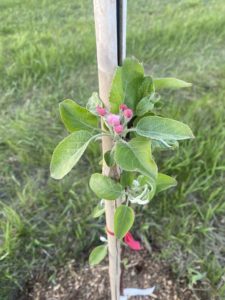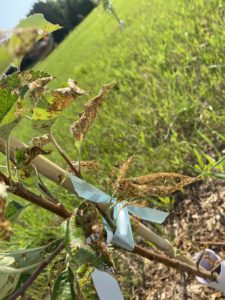I speak from experience when I tell you that any lazy hack can grow a weed. But fruit? That takes work.
Shortly before my 50th birthday last December I informed anyone who would listen that the coming decade was going to be the decade I pursued joy. It seemed like a good idea at the time. It seems like a good idea now too, but it’s not going exactly as planned. Have you ever prayed for patience? And then instead of GIVING you patience, God TEACHES you patience? Just a heads up. It works the same way with joy.
Concurrent with the dawn of the second half century of my life came a move to a home in the country on a little piece of acreage – the realization of a life-long dream. On the day the sale went through I declared myself a farmer and began turning dreams into realities. Thankfully I have a day job, because it’s possible that I’m not a very good farmer. But I am persistent. My long-suffering and very handy husband has helped me move fences, build a chicken coop, create an electric fence enclosure to protect my two little bee hives (with room for 10 more), dig a garden much too large for me to maintain well at all, and plant 101 one-year-old apple trees (and that IS the short list). The past year has been an epic and exhausting adventure of learning and doing new things. I have never had my own chickens, bees or orchard, and my past attempts at growing my own vegetables have been…how do I say this?…fraught with distraction and inconsistency both in labour expended and in the rewards of said inconsistent labours.
Fellow gardeners (and I appropriate that term with as little sincerity as I do the term farmer because I deserve neither), have you noticed how easy it is to grow a weed? Early in the spring, about the same time I killed all my tomato seedlings while trying to “harden them off”, I decided to dig a garden. I had mapped it out and it turns out that in order to grow the bounty that I and all my friends, neighbours and unexpected visitors would need, I was going to need a very large garden. So I rented a gas powered “self-propelled” sod stripper. I must pause to explain that self-propelled is a relative term. This self-propulsion is in fact a jerking, heaving motion in which at one moment it’s helpless victim is chasing behind the machine as it shreds turf voraciously, and the next is being thrown to one side or another as it catches and viciously spins around rocks, roots and occasionally absolutely nothing. Its somewhat unpredictable trajectory re-sized my dream garden from an already impressive 40 x 80 foot rectangular plot to a roughly 70 x 110 foot gaping wound on the north side of our property.
Unpleasant as my day long sod stripping adventure was, I persisted, because I knew if I was going to have any chance against the weeds, I needed a blank canvas. I will save you the details of my adventure the following day with the similarly self-propelled tiller, and instead share the happy moment when my neighbour in his shiny orange Kubota with a tilling attachment did in twenty minutes what I had all but given up hope of accomplishing in the remainder of my natural life. Suffice it to say that stubbornness and the kindness of a neighbour made my garden possible. The previous owners of our home had kindly left a pile of decomposing hay and horse poop that seemed the perfect boost to my new plot and with my dad’s help it was spread throughout my garden. Seemed is the operative word here, but I will return to that. Big dreams were happening now. My garden began to look like an archeological dig as I used twine and sticks to cordon off sections for each of my future crops. The early crops that were cold hardy, like spinach and beans, I planted. The rest were lovingly assigned their spaces on my graph paper rendering of the future most fruitful garden ever in existence.
But back to the hay and horse poop. Did you know that horse poop is full of every seed they have ever eaten? Did you know hay (unlike straw) is FULL of seeds as well that, even when mostly decomposed, are apparently some of the most virile seeds in existence. Had I been either a real farmer or a real gardener, this was information I would have known. But since I am an imposter, I had no
idea. Last summer my garden grew, and grew and grew and grew. By mid summer, in addition to a remarkable amount of intentionally grown produce (given my absolute ineptitude as a gardener), weeds grew. I don’t mean dandelions and a bit of crabgrass though I had both in abundance. I mean chest height, so thick you could barely wade through them without a machete, stealing the sun and nutrients from everything I wanted to grow kind of weeds. I didn’t plant them (intentionally). I certainly didn’t allocate any of my beautifully planned plots of garden to them, but they grew. My goodness did they grow!
So when I say that any lazy hack can grow a weed, I am telling you, any lazy hack can grow a weed.
By contrast, wander back through time to November of last year when my garden was only a twinkle in my eye and a tweak in my back. I had spent the previous two months researching apple varieties. I had to learn which ones would flower at which times of the spring so that I could make sure there would be different varieties to pollenate one another. I had to check to make sure if I bought any diploid varieties (Yep! Diploid!) that I had at least two others nearby for proper pollination. I researched what apple diseases were most prevalent in my area and which root stock would fare best against them. I marked off rows 15 feet apart using a piece of pipe and a string marked at 15 foot increments where each tree was to be ideally placed. I peeled sod (by hand that time) off of 101 two foot by two foot sections of very hard packed ground and dug holes to plant my precious bare root trees. (Hubby and parents assisted with the planting or I never would have accomplished it before all the trees died). Once planted, I placed newspaper around each tree and heaped mulch on top for weed abatement and moisture retention, careful to keep it a couple of inches from the trunk to discourage fungal growth, and then wrapped each trunk with a few inches of white plastic to discourage rodents from snacking on them over the winter. I drove a stake into the ground near each trunk and tied it just loosely enough that the wind could still blow it around but that it wouldn’t fall over. I carefully pruned them, apologizing with each snip and explaining the purpose behind what they may have misinterpreted as a malicious act.

When the winter winds blew and the snow began to fly I spent less time with them but still wandered down to check on them and make sure they were sleeping peacefully. As the spring progressed I eagerly and agonizingly checked every single tree for signs of life. For the longest time I was convinced I had killed them all, but somehow by late April every one of them had developed buds and many had leaves. One even blossomed!
I was so excited to watch their growth but also distracted by chickens and my newly acquired bees, so it was a sudden shock when one afternoon I realized a plague had descended on my apple trees. Little green beetles with thorny looking legs were skeletonizing my leaves! It was horrific. I researched, learned the name of the demons – rose chafer beetles – and that there wasn’t much I could do to kill them at this phase of their lives since I am trying to keep my “farm” organic. The only treatments for these monsters were chemicals, so instead I grabbed a large bucket with about 8 inches of soapy water in the bottom and went tree by tree picking them off one or sometimes two or three at a time (they were plentiful) and hurling them to their deaths in the sudsy foam. 101 trees! Some of these trees had as many as 20 or more beetles. In the following days, every time I went to check I found more. It was infuriating! But eventually I won the battle, which is to say, I suspect the beetle phase of their life cycle ended and my trees were left to heal. I found a recipe for an organic pest control/fertilizer and bought a back pack sprayer and all of the disgusting smelling ingredients. I felt like a ghost buster wandering my 3 foot high orchard wearing a big plastic backpack drenching each leaf with care. I learned yet another valuable lesson while spraying my trees: when your spray smells like rotting fish, it is wisest to spray standing down wind.

My little trees had been recovering well when I began to notice leaves browning and curling. Upon investigation, I found spider-like webbing full of little black dots. Panicked social media appeals resulted in diagnoses ranging from spider mites to leaf curl bugs to some kind of caterpillar. Everyone agreed that only a chemical spray would rescue my little ones! I valiantly (and foolishly) soaked them with more of my organic spray, as well as something called BTK which was also organic that 1 out of 10 apple growers highly recommended as an effective way of killing whatever might hatch from the tiny black dots (though there was still no consensus as to what that might be). Enlisting the help of my parents who had dropped by for a cup of tea at what turned out to be an inopportune moment, we plucked off most of the diseased leaves which I later burned. The end result of this was some very bald and sad looking little trees.
If my efforts were effective, and I fear that is unlikely, next year there will still be 101 little sticks with clusters of leaves on them for which I will have to wage war bucket in hand, backpack strapped on. And maybe, by the grace of God, if I do that well enough and am still living in this house in another three or four years, I will get some apples!
So when I tell you that growing fruit is work, I also know that of which I speak.
I told you all of that to tell you this; I don’t think it’s a mistake that scripture refers to the fruit of the Spirit as fruit. Fruit doesn’t just pop up on a tree overnight my friends. Maybe 15 years from now, after nurturing my trees carefully and diligently, the fruit will appear more readily. Maybe the trees will be better at battling rose chafer beetles and mystery leaf-curling black dots without as much help from me. But that will only happen if I, the farmer/gardener, am willing to put in a lot of work now and for many years.
This has my brain pursuing a lot of avenues of metaphor here. For one thing, I think it’s ok that I didn’t master joy overnight on my 50th birthday. I think I may need more than a decade quite frankly. God, who I have discovered loves me personally and is determined to give me his very best, is a really good gardener. If I want to grow joy in my life, he is all about it, but he knows it is a long and sometimes difficult endeavour. The last year of my life has actually been really, really hard in a lot of ways. My family and I have faced some deep pain, some profound discouragement and some pretty overwhelming challenges. Most of that stuff is ongoing. It’s been a lot like my apple trees last winter. God mapped out the orchard, cleared the ground and planted me in exactly the soil I needed to grow. He staked me for support, but not tightly so that the wind would blow me around forcing my roots to grow deep and wide. He pruned off growth that was heading in the wrong direction so that my future branches would spread wide and apart allowing for maximum fruit growth by providing lots of sunshine to reach each and every branch with both nourishment and disease-deterring light. He let me sit in the cold and dark of winter because he knew that I, like an apple tree, cannot bear any fruit at all without a minimum number of “chill hours.” Not gonna lie, I really don’t like spiritual chill hours.
Strangely though, I think it may be spring. Maybe I’m not bearing fruit just yet, but I think I am seeing buds that will eventually form clusters of leaves from which maybe a blossom will even grow. If this is the first spring of my joy journey, I know there are still rose-chafer beetles and bugs I have never heard of and diseases that will attack. And God’s efforts at helping me may occasionally smell like rotting fish. Frankly, if I’m going to carry this metaphor far enough, I need to be ready for more winter, more miserable chill hours. But if God is my gardener, and he loves me so much that he will persist in accomplishing his purpose in me, then I am on the road to producing fruit!
I REALLY want to be a fruitful person. I want people to watch my life, see my joy hanging out among the other fruit that God is nurturing in me, and I want them to think, “That’s something I need in my life!” The journey of life is a tough one. Regardless of who you are, regardless of who your gardener is, this world is broken along with every person in it. But we each get to choose our gardener. We can try nurturing ourselves. Did you know that a bare root apple tree will die in a matter of hours if it isn’t properly planted? We don’t fare much better on our own. We can pick a clueless gardener who didn’t design us and doesn’t know much about us and probably will never figure out what those black dots were, but who sure can google! Or we can let the gardener who also designed us be the one who nurtures our growth. It will be a journey. Much of the journey will make no sense and we will often find ourselves questioning the gardener. But if we get to know the gardener, if we understand that his heart is FULL of love for us, and that he only ever allows things to happen to us that he can use to make us each produce the very best fruit, if we understand that he knows so much more about being a tree than we ever could, then one leaf at a time, one season at a time, we can become fruitful. For me, as I purse joy as a fruit, learning to trust my gardener has been life-changing. Just understanding his heart for me is making joy pop out on my scraggly little limbs. Circumstantially, my life looks pretty wintery just now. It’s not horrific, but it’s hard. But then there is joy! In the middle of the hard, there is joy because my gardener is God and he is the one growing me, and he is a really good gardener.